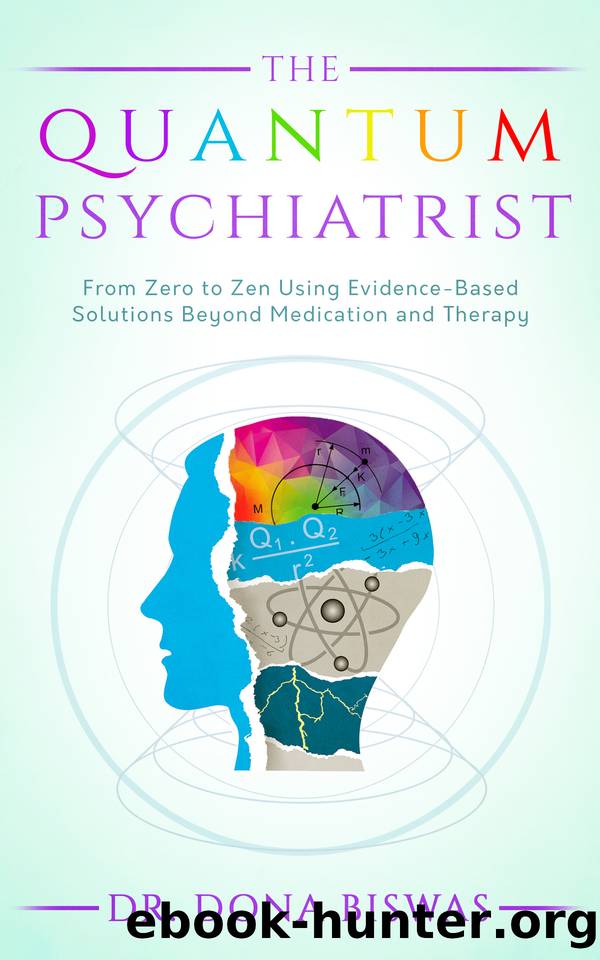The Quantum Psychiatrist: From Zero to Zen Using Evidence-Based Solutions Beyond Medication and Therapy by Biswas Dona

Author:Biswas, Dona [Biswas, Dona]
Language: eng
Format: epub
Publisher: Vital Mind
Published: 2020-08-11T16:00:00+00:00
and the person undergoing treatment experiences only mild tingling sensations around the electrode. tDCS works by reducing the resting membrane potential of the brain in the cortex below the area of stimulation. In a sense, it makes the brain more responsive to stimuli. While in itself it is not a powerful form of treatment, it can be a powerful adjuvant when combined with other neuromodulatory techniques. This can be compared to the melting of plastic to make it more pliable, after which the brain is easier to shape through other techniques, whether psychotherapy, neurofeedback or TMS.
Because of its simplicity, non-invasiveness and lack of side effects, tDCS has been investigated in fields as diverse as anxiety, PTSD, depression, pain, and even to enhance creativity. Snyder and Chi found that most subjects they recruited in their 2012 study were unable to solve the famous nine-dot problem initially. The nine-dot problem is a puzzle, wherein you are asked to join all the dots with four straight lines without taking the pen off the page. It requires out-of-the-box thinking to solve. When the investigators applied tDCS to the right anterior temporal lobe, more than 40% of participants could solve the problem! Of course, this does not imply that anyone can zap themselves with a nine-volt battery and see results, but administration of tDCS by trained personnel can augment conventional treatment methods.
A special mention about the role of tDCS in managing chronic pain: chronic pain is a classic example of the brain’s plasticity gone rogue. The pain threshold is reset so that even stimuli that were previously innocuous produce incredible pain. tDCS enables one to reactivate and re-modulate the brain’s plasticity—thus, it potentially resets the pain threshold and has been found to be extremely effective in migraines and a variety of chronic pain conditions, especially neuropathic or nerve pain.
I was first introduced to tDCS a few years back in a workshop. The device is so small that it can fit in the palm of your hand. I got my friend, who suffered from tinnitus, to try a few sessions. Initially, he did not notice anything except for a strange tingling and itchiness on the left side of his forehead, where the cathode was placed. The sensation subsided soon. After a few sessions, he reported marked improvement in his tinnitus.
IV. Cranial Electro Stimulation (CES):
Cranial electrostimulation involves delivering a small, pulsed, alternating current via electrodes on the head, mastoid process, or earlobes. It was invented in the Soviet Union in the 1950s and spread rapidly through Europe, Japan, and the United States. To date there have been hundreds of studies on the use of CES for anxiety, depression, insomnia, and pain, demonstrating significant benefits. It is widely used in the U.S. army for PTSD. CES is proposed to stimulate brain regions associated with key neurotransmitters and has been shown to increase serotonin and beta endorphins in the central nervous system. Quantitative EEG reports show it decreases delta waves while increasing alpha waves, fostering a sense of calm and well-being.
Download
This site does not store any files on its server. We only index and link to content provided by other sites. Please contact the content providers to delete copyright contents if any and email us, we'll remove relevant links or contents immediately.
The Concise Laws of Human Nature by Robert Greene(1221)
Bioenergetica by Alexander Lowen(1124)
After by Bruce Greyson(925)
The Child in You by Stefanie Stahl(883)
Stress-Proof Your Brain The Yogic Way: Unique Ancient Indian Techniques to End Toxic Stress, Stop Worrying and Inculcate Mental Toughness by Advait(874)
Badass Habits: Cultivate the Awareness, Boundaries, and Daily Upgrades You Need to Make Them Stick by Jen Sincero(789)
Talk of the Ton by unknow(733)
Chakras & Self-Care by Ambi Kavanagh(703)
The Power of Myth by Joseph Campbell & Bill Moyers(675)
Self-Care for Empaths by Tanya Carroll Richardson(636)
Learn To Think Using Thought Experiments by King Patrick(619)
The Mind by E. Bruce Goldstein(613)
No Bad Parts by Richard C. Schwartz(610)
Curative Magic by Rachel Patterson(583)
The Quantum Psychiatrist: From Zero to Zen Using Evidence-Based Solutions Beyond Medication and Therapy by Biswas Dona(551)
The 7 Secrets of Sound Healing Revised Edition by Jonathan Goldman(542)
The Tao of Intimacy and Ecstasy by Solala Towler(536)
Living a Life of Awareness by Don Miguel Ruiz Jr(528)
The Anxiety First Aid Kit by Rick Hanson(525)
